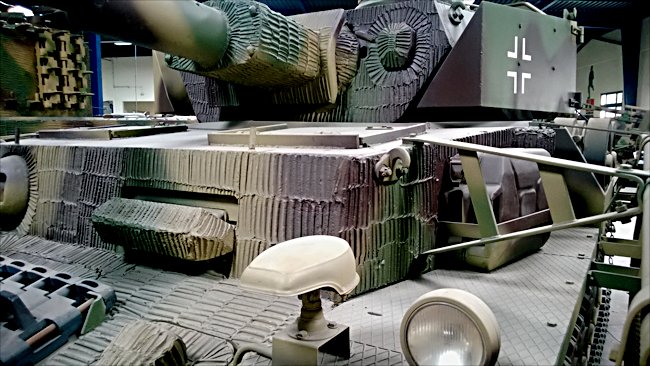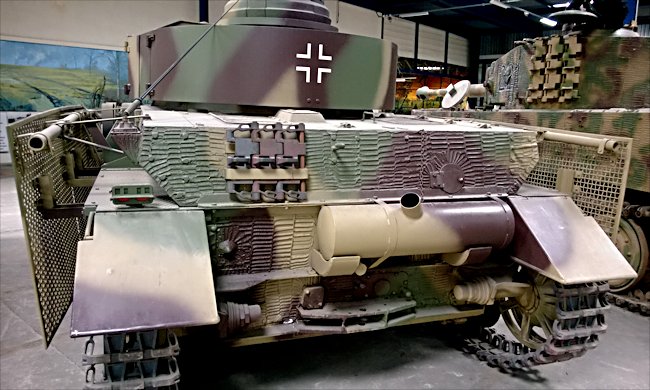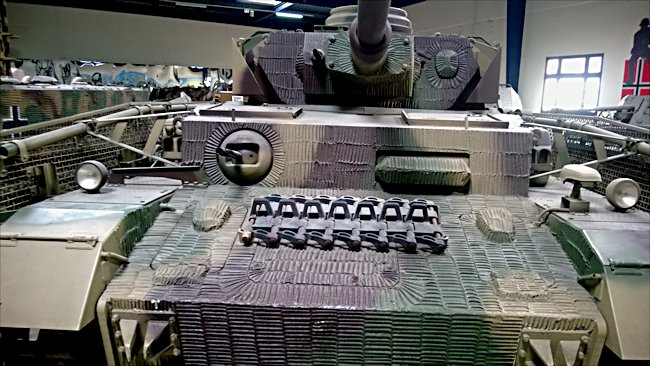The Panzer IV Ausf J
This German Panzer IV Ausf J tank panzerkampfwagen 4 Sd.Kfz.161/2 can be found at the French Tank Museum in Saumur in the Loire Valley. The Museum is called Musée des Blindés ou Association des Amis du Musée des Blindés, 1043, route de Fontevraud, 49400 Saumur, France www.museedesblindes.fr . The word Blindés means armoured.

Panzer IV Ausf J tank panzerkampfwagen 4 Sd.Kfz.161/2 with its distinctive Zimmerit anti-magnetic mine coating, turret skirts, and wire-mesh side-skirts,
This Panzer IV Ausf J tank with Fahrgestell number 89660 was built by Nibelungenwerke, Germany, in March 1944. It was rescued from one of the 'Etablissement Technique de Bourges' tank firing ranges. It was in a horibble condition, a real target range wreck when the British Cadman Brothers purchased the wreck and began the long restoration process. Large chunks of armour were missing in the turret and hull roof.
The Normandy Panzer IV tank ambush
The newly formed 12th SS Division also known as the Hitler Youth Division were ordered to reinforce Caen in Normandy after the Allies had landed on D-Day. It was led by some of Germany’s most experienced tank commanders. It was equipped with 48 panther tanks, dozens of 88mm anti-tank guns and nearly 100 upgraded Panzer mark IV tanks. They are under the command of Kurt Meyer, a decorated veteran of the Russian Front, who had a reputation as an aggressive and ruthless tank commander.
D-Day+1, Kurt Meyer and his Panzers take up a defensive position in and around the 12th Century Abbaye d’Ardennes to the west of Caen. Sherman tanks of 2nd Canadian Armoured Brigade, Sherbrooke Fusiliers Regiment were advancing towards Caen from the village of Buron, Supporting the North Nova Scotia Highlanders.

Panzer IV Ausf J tank panzerkampfwagen 4 Sd.Kfz.161/2
From high on top of the Abbey tower Kurt Meyer can see them coming. He saw what a great opportunity he had to set up an ambush. He gave instructions that no one was to fire without his orders. He placed all his tanks and guns to the side of the oncoming Canadians.
Totally unaware of the peril they were in, the Canadians stopped just in front of the Abbey and made a cup of tea and ate their rations. They had no protection on their flank. The signal was then given for the attack and the German Panzer IV tanks came out of hiding and fired at the side of the stationary Sherman tanks. The Canadians were caught off guard and were totally surprised.

Panzer IV Ausf J tank had additional 8-millimetre (0.31 in) turret skirts added for protection
Tank commander Canadian Captain S.V. Radley-Walters of the Sherbrook Fusiliers Regiment was caught in the ambush. "There was so much bloody smoke and dust and tanks burning that you were just in a bloody jungle. You could not see. Our commanding officer says, ‘I need some more strength forward’ and he asks my squadron commander to send a troop of tanks forward."
"All we had left was my squadron commander’s tank, my tank and one other. ‘The Germans are breaking through on your left. Move over to your left’ ordered the CO. He thought we still had a squadron left. All of a sudden the action started to move around our way. When I first saw the Panzer IV tanks they were 1,000 yards away. Each one of us had the jitters as there gun was so much more superior."
German 2nd Leutnant Fritz Langanke, 2nd SS Panzer Division, commented on facing the Sherman tank, "It was an easy opponent for us. If you were able to keep your distance then there was no need to fear a Sherman." The short barreled 75mm gun on the Sherman did not have nearly as much punch as the long barrelled 75mm gun on the Panzer IV tank. "

Panzer IV Ausf J tank panzerkampfwagen 4 Sd.Kfz.161/2
Captain S.V. Radley-Walters continued, "You have to start playing the game of tactics. I start firing my smoke in front of them. They were about 1,000 yards away. I said. ‘For Christ Sake let them come in close. Watch the right hand corner where I just put down the smoke because you may see something coming around the corner there taking a look at us.’ Sure enough, you see a tank, just sticking his nose through the smoke, taking a look. Trying to get some view of us. Finally I said, ‘Fire.’ I hit him at 800 to 900 yards. I can always remember the thing actually burning."
It was his first tank kill and by the end of the war he would be accredited with seventeen and be decorated as Canada’s leading tank ace. During this engagement the Canadians take a beating and lose 28 tanks, 110 men are killed and 128 are taken prisoner. Some of the Canadian prisoners are executed in the grounds of the Abbey.
The Panzer IV tank's role in the Battle of France May 1940
The Panzer Mark IVb tank was designed as an infantry support tank. It was equipped with a short low velocity 75 mm cannon firing high explosive HE shells. It was intended to deal with enemy infantry and anti-tank guns.
Though first planned in 1935, it wasn't until 1939 at the Panzer IV finally came off the production line. Though intended to make up 25% of an armoured divisions strength, the 278 tanks at fought in France in May 1940 constituted only 2% of total German armoured strength.
It was powered by a 320 hp diesel engine. It weighed 17.7 tonnes. They had a road speed of 25 mph. Its suspension system was a simple bogie arrangement. Its maximum armour thickness was only 30 mm in 1940. Later on in the war, with the upgraded armour and gun, it would make up the main body of German armoured divisions.
By may 1940 every tank Battalion had a median tank company of 6 to 11 Panzer Mark IV's. At the start of the campaign against France. There were 280 equipping the blitzkrieg Panzer divisions as they enter France.
WW2 tank books

